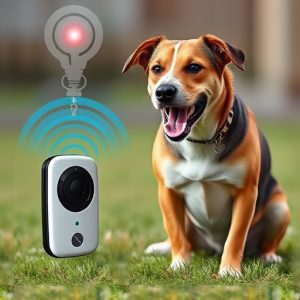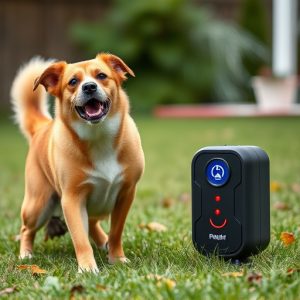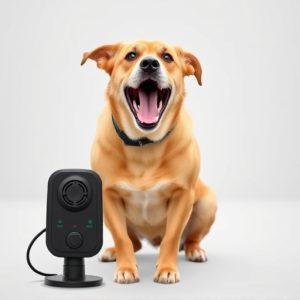Handheld vs Wall Mounted Ultrasonic Repellents: Effective Pet Behavior Control
This text compares handheld and wall-mounted ultrasonic pet repellents, highlighting their unique ad…….
This text compares handheld and wall-mounted ultrasonic pet repellents, highlighting their unique advantages for different settings. Handheld devices offer portability for outdoor or feral animal management, flexible placement, and adjustable frequency settings. In contrast, wall-mounted solutions provide continuous indoor protection against specific behaviors like scratching or chewing with consistent sound coverage and safety within approved frequency ranges. The choice depends on the home's layout and desired behavior modification.
“Unleash a new approach to pet behavior management with sound wave pet behavior control—a cutting-edge solution that leverages the power of ultrasound. This comprehensive guide explores how handheld and wall-mounted ultrasonic repellent devices can gently train pets, offering effective deterrents for unwanted behaviors.
Dive into our analysis comparing handheld vs wall-mounted options, uncovering strategic placement tips, safety considerations, and which method reigns supreme for optimal results in pet training.”
- Understanding Sound Wave Pet Behavior Control: The Basics
- Handheld Ultrasonic Repellents: Portable Solutions for Pet Training
- Wall-Mounted Devices: Strategic Placement for Effective Deterrence
- How Ultrasound Frequencies Affect Pets: Safety and Efficacy Considerations
- Comparative Analysis: Handheld vs Wall Mounted for Optimal Results
Understanding Sound Wave Pet Behavior Control: The Basics
Sound wave pet behavior control is a non-lethal method that utilizes ultrasonic sounds to modify animal behavior. At its core, this technology involves emitting high-frequency waves that are inaudible to humans but can be detected by pets like dogs and cats. These sound waves can be used for various purposes, from training and disciplining pets to keeping them away from certain areas or objects.
One key distinction between handheld and wall-mounted ultrasonic repellents is their deployment strategy. Handheld devices are portable and allow users to target specific animals on the move, making them ideal for outdoor use or when dealing with problematic feral animals. Wall-mounted repellents, on the other hand, are designed for indoor settings, offering continuous protection against persistent pet problems like scratching or chewing. Both types leverage the same ultrasonic technology but cater to different needs, providing pet owners with versatile solutions tailored to their specific situations.
Handheld Ultrasonic Repellents: Portable Solutions for Pet Training
Handheld ultrasonic repellents offer a portable solution for pet training, allowing users to target specific areas or behaviors on the go. Unlike wall-mounted devices that are permanently installed, handheld options provide flexibility and convenience. These compact gadgets emit high-frequency sound waves that are inaudible to humans but can effectively deter pets like cats, dogs, and rodents from unwanted spaces or actions. They’re ideal for training sessions in various locations, from homes to outdoor patios, without the hassle of installing fixed equipment.
In comparison to wall-mounted ultrasonic repellents, handheld devices offer greater maneuverability, making them suitable for temporary situations or areas where permanent fixtures aren’t feasible. Their portability also facilitates easy adjustment of frequency settings to match different pet species and behaviors, ensuring a more personalized approach to training.
Wall-Mounted Devices: Strategic Placement for Effective Deterrence
Wall-mounted devices offer a strategic advantage in sound wave pet behavior control, especially when compared to handheld ultrasonic repellents. Strategically placed near entry points, windows, and common gathering areas, these fixed devices can provide consistent and targeted deterrence. Unlike handheld options that require continuous operation and manual adjustment, wall-mounted models are designed for long-term effectiveness, reducing the need for constant intervention.
The strategic placement of wall-mounted devices enhances their ability to control pet behavior effectively. By integrating them into the home’s infrastructure, these systems become part of a comprehensive solution, ensuring pets stay in designated areas and away from off-limits zones. This proactive approach not only mitigates damage but also fosters a peaceful and controlled environment for both pets and homeowners alike.
How Ultrasound Frequencies Affect Pets: Safety and Efficacy Considerations
Ultrasound frequencies, typically above 20 kHz, are often employed in pet behavior control devices, such as ultrasonic repellent systems. These high-frequency sounds are invisible to the human ear but can be effective in modifying animal behavior. When it comes to using ultrasound for pets, safety and efficacy are key considerations.
One important distinction lies between handheld and wall-mounted ultrasonic repellents. Handheld devices offer portability, allowing for easy movement around the home or yard. However, their effectiveness might vary depending on the pet’s sensitivity to ultrasound and the device’s output intensity. Wall-mounted systems, on the other hand, provide a more permanent solution, offering consistent sound coverage in specific areas. These devices are generally considered safer as they operate within approved frequency ranges and power levels, ensuring minimal harm to pets and humans while still encouraging desired behavior changes.
Comparative Analysis: Handheld vs Wall Mounted for Optimal Results
When it comes to sound wave pet behavior control, the choice between handheld and wall-mounted ultrasonic repellents is a crucial one for achieving optimal results. Handheld devices offer flexibility, allowing users to move them around easily to target specific areas where pets tend to congregate or cause mischief. This portability is especially beneficial in homes with multiple levels or open floor plans, enabling quick adjustments as pet behavior patterns shift.
On the other hand, wall-mounted ultrasonic repelents provide a more permanent and strategic solution. By installing these devices in fixed locations, you can create a consistent and continuous sound barrier that disrupts pet behavior over larger areas. This is particularly effective for addressing persistent issues like cat or dog barking, scratching, or jumping on furniture. Wall-mounted options also tend to be more powerful, emitting high-frequency sounds that are less likely to be blocked by obstacles compared to handheld devices.
When it comes to managing pet behavior, handheld and wall-mounted ultrasonic repelents offer distinct advantages. Each approach has its strengths, with handheld devices providing portability for on-the-go training and wall-mounted solutions ensuring strategic deterrence in specific areas. In the debate of handheld vs wall-mounted, understanding how ultrasound frequencies affect pets is key to making an informed choice. Ultimately, the optimal solution lies in combining these methods for comprehensive pet behavior control that respects safety, efficacy, and convenience.


